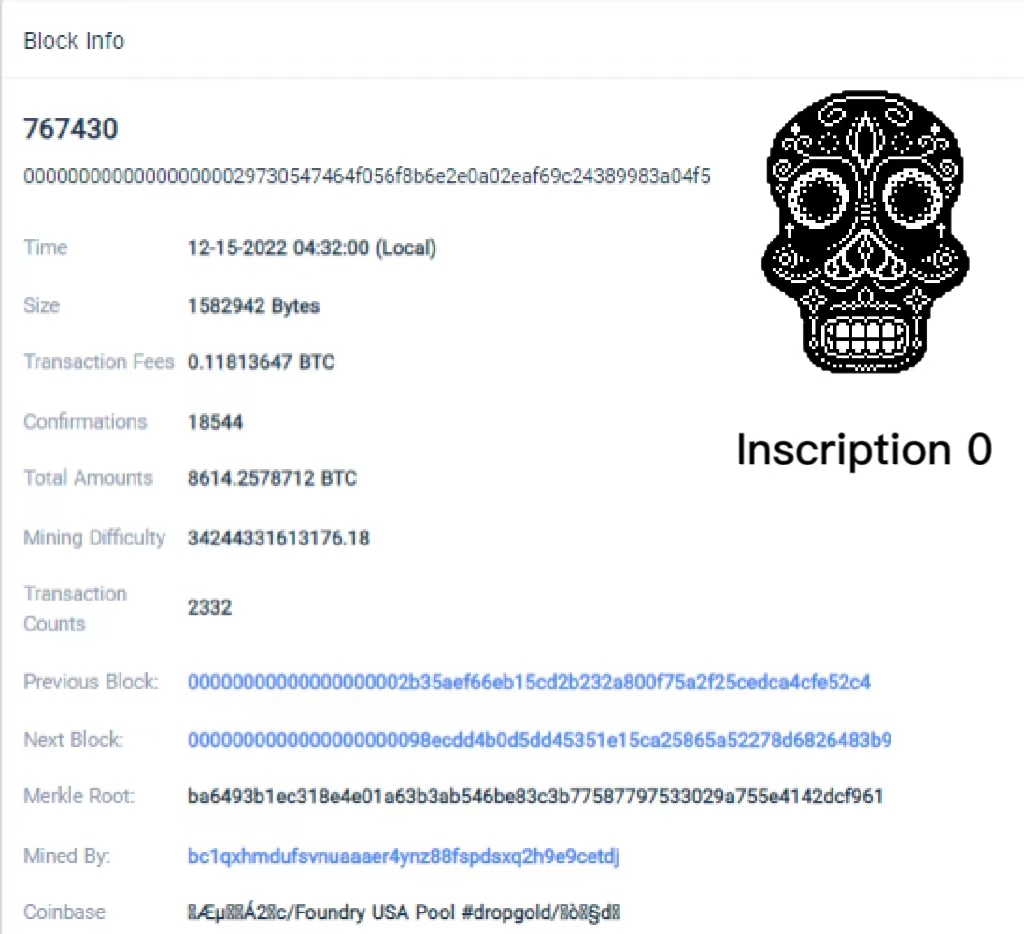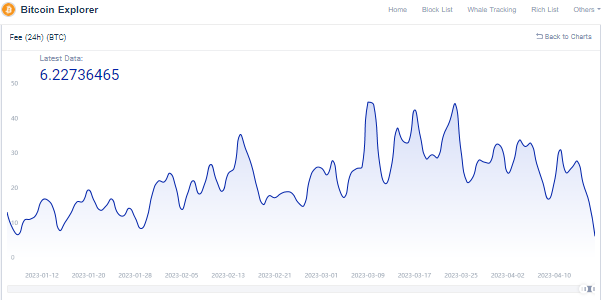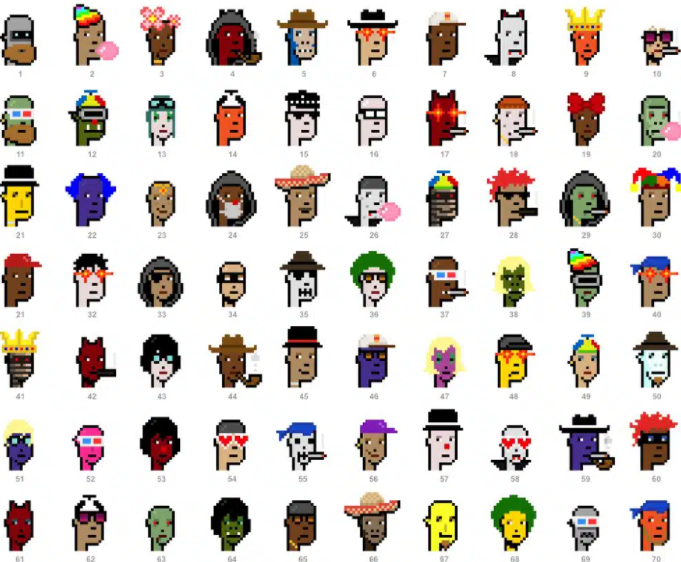Issuing NFTs on the Bitcoin blockchain? ordinals did it!
With the popularity of NFT based on the Ethereum ERC-721 standard in 2021, Casey Rodarmor, a programmer and artist, smelled an opportunity to create an NFT-like but unique experience on the Bitcoin blockchain. And so Bitcoin NFT was born.
What are Bitcoin ordinals
Bitcoin ordinals, a method of inscribing digital content on the Bitcoin blockchain. The Bitcoin ordinals protocol will officially launch on the Bitcoin mainnet in January 2023. The protocol allows users to create bitcoin versions of NFTs — described on the bitcoin network as “digital artifacts” — that support content in JPEG image, PDF, video or audio formats. Similar to many NFT projects on the Ethereum chain, these "digital artworks" will be minted on the Bitcoin network. The genesis ordinal is the skull pixel art inscribed by Rodarmor on 2022-12-14 20:32:00 UTC at block height 767430. In the four months so far, 1.168 million Bitcoin NFTs have been minted.

image description

The daily transaction fee change trend of Bitcoin from January to April. Source Tokenview
How do Bitcoin ordinals work?
Bitcoin ordinals are based on the ordinals protocol. Each bitcoin is broken down into 100 million units called satoshis (or sats). The Ordinals protocol allows those operating a Bitcoin node to inscribe each sat with data, creating something called an Ordinal. Data inscribed on Bitcoin can include smart contracts, making it possible to mint NFTs on the BTC blockchain.
Rodarmor explained that the NFT of the Ordinals protocol is created by writing arbitrary content (including text/pictures/audio/video,) on sats. In short, the Ordinal protocol expresses sats, the smallest unit of bitcoin, in the form of NFT, making them non-tamperable and tradable digital collectibles. 1 bitcoin (BTC) consists of 100 million sats.
For example, when Satoshi Nakamoto dug out the genesis block, he dug out 50 bitcoins at the same time. Ordinals are numbered from 0 according to the time order in which each sats was mined. The number of the first sat in the first block is 0, the number of the second sat is 1, and the number of the last sat of the 50th bitcoin is 4999999999, so each sats has an ID attribute. The Ordinals protocol allows bitcoins to be tracked, transferred and given meaning.
Crypto Punks is the first project to issue NFTs on the Bitcoin network. Ordinal Punks includes 100 unique PFPs minted entirely within the first 650 inscriptions on the Bitcoin chain.

Ordinals vs. traditional NFTs
Both Ordinals and traditional NFTs are unique and immutable. But from a technical design perspective, Ordinals are different from traditional NFTs. Bitcoin Ordinals only exist on the blockchain and are completely immutable; while NFTs can exist off-chain.
NFTs on Ethereum typically point to off-chain data on the Interplanetary File System (IPFS: a decentralized file storage system). Kind of like the hard drive of a blockchain - it can be changed using dynamic metadata. To illustrate, some NFT projects update the metadata of individual NFTs to improve image quality. They might even ask their holders to click the "refresh metadata" button on OpenSea to get new, higher quality images.
In Rodarmor's vision, NFTs are "incomplete" because many require off-chain data. Ordinals, on the other hand, are "complete" in that all data is recorded directly on-chain. That's why Rodarmor refers to them as digital artworks, not Bitcoin NFTs. Additionally, NFTs often come with creator royalties, while digital artwork does not.
Ordinals can be minted directly onto the Bitcoin chain, just like Bitcoin. NFTs, on the other hand, usually require a separate minting process on a smart contract platform. All of this is to suggest that ordinal numbers on Bitcoin might not only signal a cultural change for Bitcoin — they might actually be a technical improvement over NFTs.
Another key difference with bitcoin ordinals is how rarity is derived and priced around NFTs. For traditional Ethereum-based NFTs, the attributes of the art often define the rarity of the NFT, and subsequently its price. In the case of the Ethereum Name Service (ENS), limited supply drives value.
However, with bitcoin ordinal, pricing will be defined by the moment of truth represented by a bitcoin block. The original 1,000 or 10,000 inscriptions may still be treasured by collectors. The founders of bitcoin ordinal came up with a simple framework where key events would determine the rarity of sats and the inscriptions inscribed on them.
These key events include:
Blocks: The Bitcoin network produces a block approximately every 10 minutes. The first sat of each new block will be rarer than the other sats of that block.
Difficulty Adjustment: Approximately every two weeks (2016 blocks) the Bitcoin network modifies the network hashrate by adjusting the difficulty target a block must achieve to be accepted. The first sat for the difficulty adjustment that occurs every two weeks will be even rarer.
Halving: Approximately every four years (210,000 blocks), the number of new bitcoin sats generated in each block is cut in half. With the next halving scheduled for 2024, the first sat of each halving period will add another level of rarity.
Reincarnation: After every six halvings, the halving and difficulty adjustment will occur at the same time. Happens approximately every 24 years. And the first sat of this adjustment period, will be another level of rarity.
From this it is possible to classify the rarity classes:
common: any sat not in the first block
Uncommon: the first sat in each block
Rare: first sat per difficulty adjustment
Epic: the first sat of each halving
Legendary: the first sat of each round
mythic: the first sat of the genesis block
According to the founders, this could differentiate bitcoin ordinals from NFTs and make their rarity truly random, not controlled by the founding team of NFT collections or their artists.